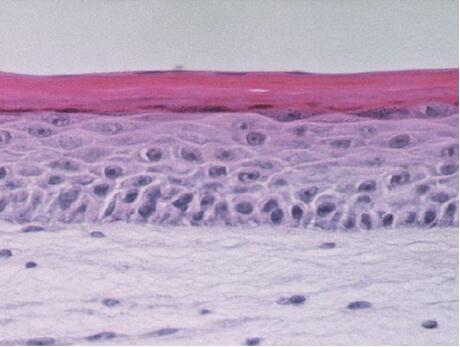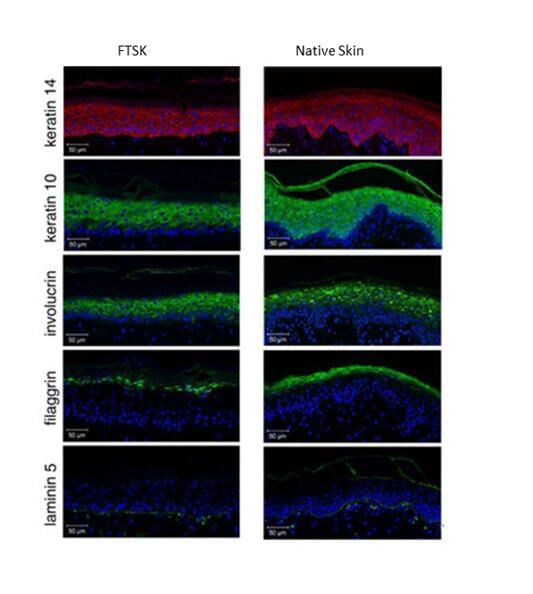- You are here: Home
- Applications
- Skin
- In vitro Skin Models
- In vitro Full Thickness Skin Model
Applications
-
Cell Services
- Cell Line Authentication
- Cell Surface Marker Validation Service
-
Cell Line Testing and Assays
- Toxicology Assay
- Drug-Resistant Cell Models
- Cell Viability Assays
- Cell Proliferation Assays
- Cell Migration Assays
- Soft Agar Colony Formation Assay Service
- SRB Assay
- Cell Apoptosis Assays
- Cell Cycle Assays
- Cell Angiogenesis Assays
- DNA/RNA Extraction
- Custom Cell & Tissue Lysate Service
- Cellular Phosphorylation Assays
- Stability Testing
- Sterility Testing
- Endotoxin Detection and Removal
- Phagocytosis Assays
- Cell-Based Screening and Profiling Services
- 3D-Based Services
- Custom Cell Services
- Cell-based LNP Evaluation
-
Stem Cell Research
- iPSC Generation
- iPSC Characterization
-
iPSC Differentiation
- Neural Stem Cells Differentiation Service from iPSC
- Astrocyte Differentiation Service from iPSC
- Retinal Pigment Epithelium (RPE) Differentiation Service from iPSC
- Cardiomyocyte Differentiation Service from iPSC
- T Cell, NK Cell Differentiation Service from iPSC
- Hepatocyte Differentiation Service from iPSC
- Beta Cell Differentiation Service from iPSC
- Brain Organoid Differentiation Service from iPSC
- Cardiac Organoid Differentiation Service from iPSC
- Kidney Organoid Differentiation Service from iPSC
- GABAnergic Neuron Differentiation Service from iPSC
- Undifferentiated iPSC Detection
- iPSC Gene Editing
- iPSC Expanding Service
- MSC Services
- Stem Cell Assay Development and Screening
- Cell Immortalization
-
ISH/FISH Services
- In Situ Hybridization (ISH) & RNAscope Service
- Fluorescent In Situ Hybridization
- FISH Probe Design, Synthesis and Testing Service
-
FISH Applications
- Multicolor FISH (M-FISH) Analysis
- Chromosome Analysis of ES and iPS Cells
- RNA FISH in Plant Service
- Mouse Model and PDX Analysis (FISH)
- Cell Transplantation Analysis (FISH)
- In Situ Detection of CAR-T Cells & Oncolytic Viruses
- CAR-T/CAR-NK Target Assessment Service (ISH)
- ImmunoFISH Analysis (FISH+IHC)
- Splice Variant Analysis (FISH)
- Telomere Length Analysis (Q-FISH)
- Telomere Length Analysis (qPCR assay)
- FISH Analysis of Microorganisms
- Neoplasms FISH Analysis
- CARD-FISH for Environmental Microorganisms (FISH)
- FISH Quality Control Services
- QuantiGene Plex Assay
- Circulating Tumor Cell (CTC) FISH
- mtRNA Analysis (FISH)
- In Situ Detection of Chemokines/Cytokines
- In Situ Detection of Virus
- Transgene Mapping (FISH)
- Transgene Mapping (Locus Amplification & Sequencing)
- Stable Cell Line Genetic Stability Testing
- Genetic Stability Testing (Locus Amplification & Sequencing + ddPCR)
- Clonality Analysis Service (FISH)
- Karyotyping (G-banded) Service
- Animal Chromosome Analysis (G-banded) Service
- I-FISH Service
- AAV Biodistribution Analysis (RNA ISH)
- Molecular Karyotyping (aCGH)
- Droplet Digital PCR (ddPCR) Service
- Digital ISH Image Quantification and Statistical Analysis
- SCE (Sister Chromatid Exchange) Analysis
- Biosample Services
- Histology Services
- Exosome Research Services
- In Vitro DMPK Services
-
In Vivo DMPK Services
- Pharmacokinetic and Toxicokinetic
- PK/PD Biomarker Analysis
- Bioavailability and Bioequivalence
- Bioanalytical Package
- Metabolite Profiling and Identification
- In Vivo Toxicity Study
- Mass Balance, Excretion and Expired Air Collection
- Administration Routes and Biofluid Sampling
- Quantitative Tissue Distribution
- Target Tissue Exposure
- In Vivo Blood-Brain-Barrier Assay
- Drug Toxicity Services
In vitro Full Thickness Skin Model
Compared to animal experiments or the use of ex vivo skin, in vitro 3D Full Thickness Skin Model (Human Skin Equivalent, FTSK, HSE) used under defined test conditions offer several advantages: i) since most models are composed of primary human cells, inter-species extrapolation is avoided; ii) in contrast to ex vivo human skin, repeated application of formulations can be performed for at least several weeks; iii) work with the ready to use epidermal FTSK (HSE) does not require advanced knowledge of cell culture techniques; iv) the employment of FTSK (HSE) leads to the reduction of laboratory animal use in regulatory toxicology as well as in preclinical studies.
Creative Bioarray provides in vitro Full Thickness Skin Model (Human Skin Equivalent, FTSK, HSE) to our customers for developing innovative skin care products, and to cosmetic scientists for evaluating novel ingredients and formulations.
Creative Bioarray Reconstructed FTSK (HSE) are composed of a dermal compartment containing human skin fibroblasts embedded in a collagen matrix and human keratinocytes seeded on top to form the epidermis.
Creative Bioarray Full Thickness Skin Model Feature
- The skin model closest to clinical testing
- Large donor inventory with matched keratinocytes and fibroblasts
- Delivered ready-to-use
 Fig.1 Histological examination of FTSK(HSE) model
Fig.1 Histological examination of FTSK(HSE) model
Specific Markers
- Filaggrin
- Involucrin
- Loricrin
- Corneodesmosin
- Procollagne1
- Tropoelastin
- Decorin
- Perlecan
- Keratin 10
- Keratin 5
- Presence of different epidermal classes of lipids comprising ceramides
- collagen
- Laminin V
- Alpha6Beta4-integrin
- BP antigen
- Ki67
- Others
 Fig2. Fluorescence-labeling of different markers in FTSK.
Fig2. Fluorescence-labeling of different markers in FTSK. Fig3. Immunol-labeling of different markers in FTSK
Fig3. Immunol-labeling of different markers in FTSKApplications
Creative BioarrayFTSK (HSE) can be utilized for the evaluation of toxicity and efficacy of skin therapeutics and cosmetics.
- skin irritation
- skin sensitization
- genotoxicity
- Pigmentation
- skin barrier function & moisturizing
- anti-aging
- stress / inflammation
- UV protection
Quote and ordering
Our customer service representatives are available 24hr a day!
Related models
In vitro Reconstructed Human Epidermis (RHE)
Ex vivo Skin Explants
Neurodermatology Skin Model
Pigmented Epidermis Model
Psoriasis Skin Model
Explore Other Options
For research use only. Not for any other purpose.

